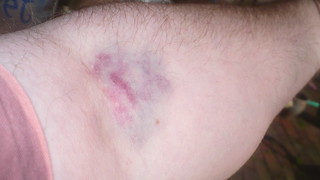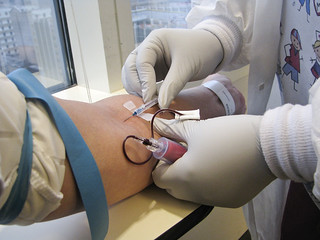By Rick Fromme
Why was the young vampire considered a failure? Because he
fainted at the sight of blood.
Yes, it’s natural to quip about vampires when thinking about
venipuncture and phlebotomy. It’s easy
to get — shall we say, “stuck”? — in that mode of thought. Especially since the previous article I’d
posted was among our ongoing “Humerus Я Us,” series, I’m
still in a mirthful mode about merry medicine.
But the “point” I want to stress is: Blood testing is a critical
component in anyone’s overall health care, whether for assessment, benchmarking,
the identification of disease, and other issues. For aging adults — and that’s a majority of the
U.S. population — blood testing is the most critical step to prevent life-threatening
issues. From a battery of different blood tests, health care professionals can watch
for and catch critical physiological changes before they manifest as heart disease,
cancer, diabetes, multiple sclerosis, Alzheimer’s and other debilitating illnesses.
Blood tests can also help one attain a higher quality of life.
For example, by monitoring levels of testosterone, estrogen and progesterone, one
can take definitive steps to correct a depressive mental state, reduce abnormal
obesity, improve memory, increase energy levels, and more.
Of course, the health care specialty that focuses on obtaining
blood for these critical tests is phlebotomy. And, as I’d mentioned in my previous
blog, “Health
Care Jobs Outlook is Jammin’!” one of the top 20 career specialties that’s expected
to grow exponentially is phlebotomy.
 |
| Medic Red Stewart performs a phlebotomy at a JTF-GTMO medical clinic. (Photo credit: Wikipedia) |
Phlebotomists draw blood for tests, transfusions, research, or
blood donations. Some explain their work to patients and provide assistance when
patients have adverse reactions after their blood is drawn. Phlebotomists work mainly
in hospitals, medical and diagnostic laboratories, blood donor centers, and doctor’s
offices.
In a hospital setting, phlebotomists receive orders from the
various departments, then take the required tubes in their portable tray. Once in
the patient’s room, they carefully identify the patient by their name, medical record
number, and date of birth, before drawing the required specimens. The carefully marked tubes are then returned
to the lab and the requisite information for each is inputted into the
computer. Then the tubes are delivered to the proper departments such as hematology,
coagulation, chemistry, etc., for the techs to then result out the tests.
The actual venipuncture process consists of applying a tourniquet,
selecting a vein, cleansing the skin, inserting a needle, and collecting blood for
either testing or transfusion purposes. Upon
completion of collection, the needle is withdrawn into a safety device, which prevents
re-use of the needle and accidental needle sticks. The needle is then discarded
into a biohazard sharps container.
Depending upon a variety of factors that can affect the size
and availability of patients’ veins, this process can go smoothly or sometimes needs
to be repeated to obtain results. Many seniors, for example, have hard-to-find veins.
Children, too, can sometimes prove difficult not only because of the smaller size
of their veins, but their outwardly manifested fear factor of the venipuncture procedure
itself.
 |
| Yet Another Bad Phlebotomy Job (Photo credit: A.Currell) |
Phlebotomists perform a key diagnostic service in a wide range
of health care settings. Depending upon what a patient’s condition is, their ability
to obtain proper blood samples could ultimately be life saving. Another good part
of the job, many phlebotomists say, is their time spent interacting with patients
(and hopefully executing a flawless venipuncture/withdrawl). Especially in a large
hospital setting or a major urban laboratory, the range of patients and personalities
are quite varied.
Keep in mind that drawing someone’s blood, inserting a needle
into their skin while the patient is conscious, is a fairly intimate process. There’s
a certain unspoken trust level between the phlebotomist and patient. The patient/donor
is trusting the phlebotomist to puncture their skin, obtain accurate and requisite
amount of samples as rapidly as possible, while at the same time entrusting the
phlebotomist to cause as little pain as possible during the procedure.
Job Requirements & Training
 |
| True Blood (Photo credit: Lori Greig) |
Upon completion, especially if one’s completed an accredited
course track, then she or he can oftentimes get certified immediately. Or, after
working for a requisite amount of hours, one can take the certification test. By
becoming credentialed, phlebotomists demonstrate their competence to carry out their
responsibilities, which in turn, allow them increased job prospects, higher salaries,
and to gain the respect of other health care professionals. There are different
certifying bodies such as The American Society for Clinical Pathology (ASCP), American
Society for Phlebotomy Professionals (ASPT) and National Phlebotomy Association. Getting accredited is highly recommended to best
further one’s career opportunities.
If a would-be phlebotomist is training at a health care facility,
their coursework and training is usually variable, based on a combination of education,
experience and on-the-job training.
In this article, I discussed the highly favorable job outlook
for phlebotomists, described what their various
responsibilities are (predominately in a hospital setting), described the process of venipuncture, and also talked about educational requirements and credentialing. If you found this article useful, please feel free to share and repost it. If you have any questions or comments, as always, I’m eager to read them.
responsibilities are (predominately in a hospital setting), described the process of venipuncture, and also talked about educational requirements and credentialing. If you found this article useful, please feel free to share and repost it. If you have any questions or comments, as always, I’m eager to read them.
 |
| Combined Nuvola apps dict.png + VampireSmiley.png for use in enwiki novel stub tpl (Photo credit: Wikipedia) |
Related Articles












Like a number of other medical specialties, phlebotomy is one of those areas that most of us prefer not to dwell on.
ReplyDelete